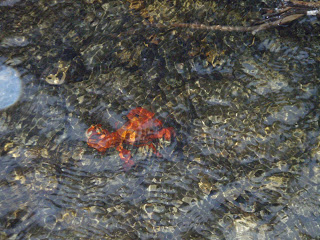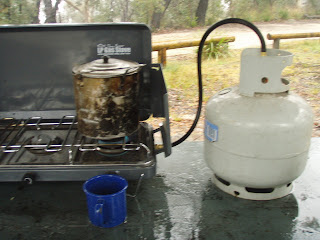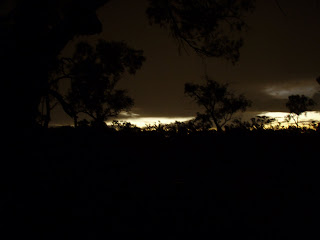As the sun began to set, a whistling kite plucked a fish from the river , and storm clouds began to gather to the west. I thought about this country. There are only two seasons- Wet or Dry. Australia is a sunburnt country , a land of sweeping plains, of ragged mountain ranges, of droughts and flooded plains... On this trip we would experience both.
As the wind came up, heavy splotches of rain began to fall, the ancient river gums, gave off a heady mixture of eucalyptus oil and honey fragrance. It was stunning. I felt small. It was the outback.
The trip took us from Kurrajong, Orange, Hillston to Willandra National Park. Then pushing further west to Ivanhoe and on to Mungo National Park. Following on to the old river port of Pooncarrie and then Kinchega. Home again via Wilcannia.
Each park is unique. Yet each park is linked with a common thread of boom times and bust, of flood and drought, of environmental disaster and of ancient discoveries.
 Washed out road.
Washed out road.As we travelled we enjoyed the wild life spotting and saw:-emu, wedge tail eagle, galah and apostle bird as well as the usual white winged chuffs. The land looked rich, with dramatic greens contrasting with vivid red soils.
A lazy young goanna defied us until I set chase......
 Goanna on its toes about to run!
Goanna on its toes about to run!
Each park had its own wildlife . At Willandra we saw a Red Capped Robin and Grey Shrike Thrush. Mungo featured Wedge Tailed Eagles and Major Mitchells. Whilst Kinchega featured Whistling Kites and Red Tail Cockatoos. All unique, all beautiful. The Whistling kite, caught the fish right where we were camped. Casually.
The roads are harsh, whilst a small vehicle would cope, certainly a stronger vehicle is advisable. In one section all the lids of the salt, pepper and coffee vibrated off!! It was important, at the end of the day to ensure that the beer was at room temperature (which out here is 30c!!)
 Maalie on a previous trip into the desert
Maalie on a previous trip into the desert
I sat and quietly reflected on my friends need for room temperature beer! Ha!
 Maalie this VB is for you.
Maalie this VB is for you.
Each night a log fire was prepared by David and enjoyed by all!

The drive out to Wilcannia was to prove a challenge. 150k of "dry condition road only". The day was sunny and the road was firm and undamaged by the rain. We pushed 50k until we were met by a sign which said the bridge was closed (unsafe). The road authority had pushed a side track through the creek below. Under normal conditions, passable. Today a flash flood had made the creek a metre high- Impassable.
 Flooded road ways and creeks.
Flooded road ways and creeks.I decided to walk the bridge and check its safety. It had a 5 tonne limit and the Landcruiser is 3.5 tonne. However once on the other side I was greeted by a sheet of running water 100m wide. In order to check depth and the ground underneath I walked across. At about 40cm in the deepest part I deemed it safe, although a challenge to cross.
However, we had a further 85kms of mud and water! the road was completely water logged and the vehicle simply sank to the axles, moving forward slowly whilst throwing clods of black soil high into the air. It was a fine balance between forward momentum, engine revs, and the correct gearing.
After 2 hours we had crossed the worst road conditions I had experienced.
 Troopie awaiting the truck wash
Troopie awaiting the truck wash
It was a great trip.
Fortunatly, the Troopie will be washed and cleaned by our detailing staff and not by me!
Bird list:-Emu, Wedged Tail Eagle, Galah, Apostle Bird, White Winged Chough, Nankeen Kestrel, Black Kite, Magpie, Pied Butcher bird, Pee-wee, Western Warbler, Rufus Whistler, Brown Thornbill, Southern White Face, Grey Shrike Thrush, Yellow Rumped Thornbill,, Red Capped Robin, Little Raven, Australian Raven, Red Rumped Parrot, Little Friar Bird, Coot, Australian Pratincol, House Sparrow, Crested Pigeon, Spiney Cheeked Wattlebird, Mulga Parrot, Common Bronze Wing, Yellow Throated Minor, Willy Wagtail, Major Mitchell, Cockatiel, Diamond Dove, Blue Winged Parrot, Western Warbler, Ring Necked Parrot (Mallie form), Fork Tailed Swift, Ausralian Pelican, White Faced Heron, Whistling Kite, Welcome Swallow, Red Tail Cockatoo, Black Kite, White Plumed Honey Easter, Red Legged Doteril, Royal Ibis, Little Eagle.





























